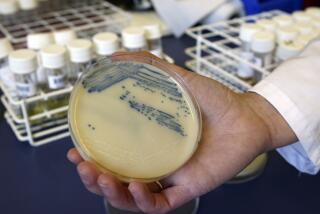Sparse crop of new antibiotics confronts ‘nightmare bacteria’
Despite surging cases of infections unresponsive to existing antibiotic drugs, the number of medications under development or receiving approval from the Food and Drug Administration is dwindling and remains “alarmingly low,” a new report warns.
Most concerning, according to the Infectious Disease Society of America, is the “near absence” of antibiotic candidate drugs capable of combating new strains of bacteria that are uniquely dangerous: These “gram-negative” bacteria are not only resistant to most available antibiotic drugs themselves, they can pass genetic materials on to other bacteria that make them impervious to existing medications as well.
These new strains of disease-causing bacteria have been dubbed “nightmare bacteria,” because they defy most standard treatments and kill many of those infected with them. The Centers for Disease Control and Prevention last month warned of a fourfold increase in the number of hospitals reporting common Enterobacteriaceae infections that show resistance to the family of broad-spectrum carbapenem antibiotics. As many as half of those infected die.
In the four years since the Infectious Disease Society of America first reported on the state of antibiotic pharmaceutical development, the Food and Drug Administration has approved two new antibiotic medications -- televancin (marketed as Vibativ) and ceftaroline fosamil (Teflaro).
Only the latter, designed to treat bacterial pneumonia and complicated skin infections, combats “gram-negative” infections, said IDSA, which has challenged the biomedical and pharmaceutical community to bring forth 10 such antibiotic drugs by 2020.
While a few companies are developing seven candidate antibiotics capable of combating multiple-drug-resistant bacteria, most of those candidates have not yet progressed to advanced stages of human testing, the report says. Work on one of those drugs was recently halted after its sponsor, GlaxoSmithKline, discovered an undefined “microbiologic finding” in subjects with urinary tract infections taking the medication.
The development of a new generation of antibiotics is plagued not just by the diabolical ingenuity with which bacteria evolve to elude widely used medications. For reasons financial and legal as well, a shrinking group of biotech and pharmaceutical companies appears willing to invest the time and money to develop such medications. Such candidate drugs are costly to develop and may have to be abandoned before they pay dividends; they may be overwhelmed by resistant bacteria before they return a profit, or treat such a small population of patients they have no prospects of becoming profitable; and they may open the company that markets them to liability when they fail.
If companies are to be encouraged to develop new antibiotics capable of going up against “nightmare” strains of bacteria, IDSA has said, they will need the federal government to relax some regulatory strictures that govern drug development, extend tax credits for research and development, offers grants to biotech companies developing high-risk candidates, and foster public-private partnerships.
Even as it presses for new antibiotic classes to be developed, the IDSA study also underscored that the nation continues to need new oral drugs to treat methicillin-resistant straphylococcus aurelius (better known as MRSA), which kills more Americans yearly than emphysema, homicide, Parkinson’s disease and HIV/AIDS combined.






